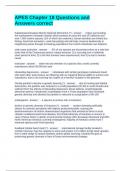-
1. Exam (elaborations) - Apes review questions and answers
-
2. Exam (elaborations) - Apes unit 1 exam review questions and answers
-
3. Exam (elaborations) - (apes) chapter 1 introduction to apes questions and answers
-
4. Exam (elaborations) - Apes unit 2 review questions and answers
-
5. Exam (elaborations) - Apes vocab questions and answers
-
6. Exam (elaborations) - Units 1-5 exam study guide apes questions and answers
-
7. Exam (elaborations) - Ap environmental science exam practice questions and answers
-
8. Exam (elaborations) - Apes exam study guide questions and answers
-
9. Exam (elaborations) - Apes a to z questions and answers
-
10. Exam (elaborations) - Apes practice exam questions and answers
-
11. Exam (elaborations) - Ap environmental science ap test review questions and answers
-
12. Exam (elaborations) - Apes biomes questions and answers
-
13. Exam (elaborations) - Apes first test questions and answers
-
14. Exam (elaborations) - Apes chapter 1 and 2 questions and answers
-
15. Exam (elaborations) - Apes review 1 earth systems and resources questions and answers
-
16. Exam (elaborations) - Apes units 5.1-5.9 questions and answers
-
17. Exam (elaborations) - Apes unit 0 questions and answers
-
18. Exam (elaborations) - Ap environmental science vocabulary questions and answers
-
19. Exam (elaborations) - Apes - 1.1 intro to ecosystems questions and answers
-
20. Exam (elaborations) - Apes unit 10 review questions and answers
-
21. Exam (elaborations) - Apes frq unit 5 questions and answers
-
22. Exam (elaborations) - Apes unit 9 questions and answers
-
23. Exam (elaborations) - Apes – forestry questions and answers
-
24. Exam (elaborations) - Apes 2.4 - 2.7 questions and answers
-
25. Exam (elaborations) - Apes unit 2 living world questions and answers
-
26. Exam (elaborations) - Apes 2.6 questions and answers
-
27. Exam (elaborations) - Apes unit 1 vocab questions and answers correct
-
28. Exam (elaborations) - Apes math questions and answers
-
29. Exam (elaborations) - Apes unit 2 test questions and answers correct
-
30. Exam (elaborations) - Apes module 24 review questions and answers
-
31. Exam (elaborations) - Apes unit 5 (5.1-5.17) questions and answers
-
32. Exam (elaborations) - Apes chapter 10 questions and answers
-
33. Exam (elaborations) - Apes unit 8 review questions and answers
-
34. Exam (elaborations) - Apes chapter 6 questions and answers correct
-
35. Exam (elaborations) - Apes module 64 questions and answers
-
36. Exam (elaborations) - Apes chapter 9 questions & answers correct
-
37. Exam (elaborations) - Apes unit 9 review questions and answers correct
-
38. Exam (elaborations) - Apes module 59 questions and answers correct
-
39. Exam (elaborations) - Apes unit 3 vocab questions and answers
-
40. Exam (elaborations) - Primary productivity – apes questions and answers
-
41. Exam (elaborations) - Apes ecosystems questions and answers
-
42. Exam (elaborations) - Apes chapter 1-6 questions and answers correct
-
43. Exam (elaborations) - Ap environmental science final exam questions and answers.
-
44. Exam (elaborations) - Apes chapter 1 questions & answers
-
45. Exam (elaborations) - Apes study guide questions and answers
-
46. Exam (elaborations) - Apes unit 1 test questions and answers
-
47. Exam (elaborations) - Apes 1.1-1.6 test questions and answers
-
48. Exam (elaborations) - Apes final exam questions and answers
-
49. Exam (elaborations) - Apes 2.5 natural disruptions to ecosystems questions and answers
-
50. Exam (elaborations) - Apes unit 8 questions & answers correct
-
51. Exam (elaborations) - Apes unit 5 the green revolution questions and answers correct
-
52. Exam (elaborations) - Apes unit 3 review questions and answers
-
53. Exam (elaborations) - Apes chapter 18 questions and answers correct
-
54. Exam (elaborations) - Ap environmental science (all units) questions & answers
-
55. Exam (elaborations) - Apes chapter 1-6 questions and answers
-
56. Exam (elaborations) - Apes-ecosystem services questions and answers
-
57. Exam (elaborations) - Apes units 1 - 4 flashcards questions and answers
-
58. Exam (elaborations) - Apes biodiversity questions and answers
-
59. Exam (elaborations) - Apes final questions and answers
-
60. Exam (elaborations) - Apes populations questions and answers
-
61. Exam (elaborations) - Apes keystone questions and answers
-
62. Exam (elaborations) - Apes population questions and answers
-
63. Exam (elaborations) - Apes types of species questions and answers
-
64. Exam (elaborations) - Apes chapter 2 questions and answers
-
65. Exam (elaborations) - Apes unit 3 progress check mcq questions and answers
-
66. Exam (elaborations) - Apes practice test multiple choice questions and answers graded a+
-
67. Exam (elaborations) - Apes module 1 questions and answers
-
Show more




